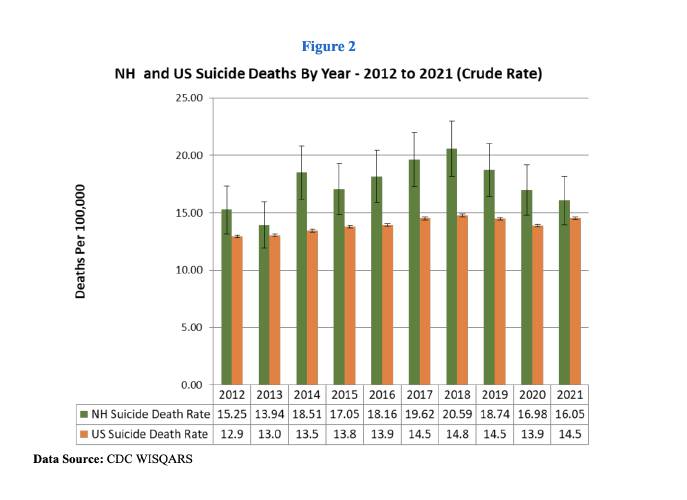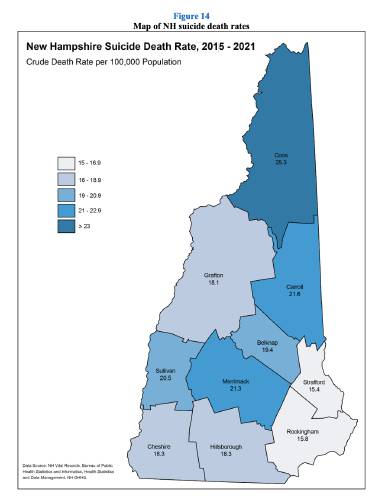Suicide rates in New Hampshire declining since 2018, report says
| Published: 04-27-2024 4:59 PM |
New Hampshire’s efforts to fight suicide have made progress, with a consistent decline in suicide death rates since 2018, according to the recently published 2022 Annual Suicide Report.
The report, compiled jointly by the National Alliance on Mental Illness NH, the State Suicide Prevention Council, and the Youth Suicide Prevention Assembly, highlights New Hampshire’s consistent annual decline in suicide deaths from 2018 to 2021.
“To see the rate drop two points again and again, that was just really hopeful,” said Amy Cook, chair of the suicide prevention council.
In 2018, New Hampshire saw 2 individuals per 10,000 population lose their lives to suicide. However, since then, these rates have steadily declined. By 2021, the figure improved to 1.6 per 10,000 population.
But Cook is cautious about the trend changing in the wrong direction as more data becomes available that reflects the effects of the pandemic on the mental health of youth and adults.
“I hate to see any trend start to creep back up. But I hear what everybody’s talking about around the table, especially in specific populations like the veterans and the LGBTQ+ youth, we have figures that aren’t looking as good,” Cook said.
But, she holds hope that the state can maintain progress toward its downward trend.
The Suicide Prevention Council is working with community members and partners to update the state’s suicide plan, including goals and action items to help reduce suicide rates and support vulnerable populations.
Article continues after...
Yesterday's Most Read Articles
 Concord may finally buy long-closed rail line with hopes of creating city-spanning trail
Concord may finally buy long-closed rail line with hopes of creating city-spanning trail
 Free speech group, residents back Bow parents’ free speech appeal in case involving transgender athletes
Free speech group, residents back Bow parents’ free speech appeal in case involving transgender athletes
 New Cheers owners honor restaurant’s original menu while building something fresh
New Cheers owners honor restaurant’s original menu while building something fresh
 ‘Perfect fit’: Fabulous Looks Boutique shifts leadership, preserving brands and styles
‘Perfect fit’: Fabulous Looks Boutique shifts leadership, preserving brands and styles
 Ayotte vetoes bathroom bill, defeating it for second time in two years
Ayotte vetoes bathroom bill, defeating it for second time in two years
While there’s a positive note in the latest report about statewide suicide rates, experts are still grappling with the persistent higher rates of suicide affecting the northern parts of New Hampshire.
Coos County stands out with the highest suicide death rate among all ages between 2015 and 2021, reaching 2.5 per 10,000 population. Following closely behind are Carroll County at 2.1 per 10,000 and Merrimack County at 2.1 per 10,000.
Strafford County emerges with the lowest suicide death rate, recording 1.5 per 10,000 population during the same period.
Elisa Bolton, the director of Psychological and Counseling Services at the University of New Hampshire, suggests that various factors may contribute to the elevated suicide rates in the predominantly rural northern areas. These factors include firearm ownership, the presence of military veterans, access to healthcare, housing stability, food security, and barriers to broader economic opportunities
Hurdles to accessing mental healthcare could be either availability, transportation or workforce shortages that make it difficult for people to receive treatment.
Cook said the industry’s struggle to hire workers is the biggest obstacle to people receiving mental health services on time, regardless of the region.
“Wait times at each Community Mental Health Center from Portsmouth to Berlin can be months depending on what type of service you need,” explained Cook. “Many facilities could take more patients if they had more staff.”
The New Hampshire Department of Health and Human Services with its Mission Zero plan is working to increase bed capacity, workforce and early intervention resources to provide better mental healthcare in the state.
Regarding gender disparities, the report highlights that while men have a higher rate of suicide deaths, women tend to have a higher rate of suicide attempts.
“Men more often than women choose firearms as a lethal means while women turn to overuse of drugs,” Cook said about the varying statistics.
When individuals resort to drug overdose as a method of suicide, there’s often a window of opportunity for intervention compared to gunshot wounds. This affords a greater chance for individuals to receive medical attention and potentially have their lives saved.
The report extensively analyzes suicide risks across various demographics through several charts and data points. However, it notably lacks data concerning the LGBTQ+ populations.
Cook noted that the majority of reports received by the Suicide Prevention Council to prepare the annual report do not include information about individuals’ sexual orientations or gender identities.
For instance, data collected by the medical examiner’s office regarding suicide deaths typically does not inquire about sexual orientation or gender identity; instead, it relies on the biological sex recorded on birth certificates.
This trend extends beyond New Hampshire and is prevalent in states across the country.
“It is very important information to collect because if we don’t understand who’s at risk and who’s affected it makes it hard to provide care for those who are really struggling,” Bolton said of gathering data on the LGBTQ+ population’s suicide risk.
National Suicide Prevention Lifeline: Call or text 988 or chat at 988lifeline.org
National Alliance for Eating Disorders: Call the helpline at +1 (866) 662-1235
The Trevor Project: A national 24-hour, toll-free confidential suicide hotline for LGBTQ youth. If you are a young person in crisis, feeling suicidal or in need of a safe and judgment-free place to talk, call 1-866-488-7386.
Veterans: To connect with a Veterans Crisis Line responder anytime day or night, dial 988 then Press 1









 ‘A little piece of everything I like’: New Pittsfield barbershop brings more than a haircut to downtown
‘A little piece of everything I like’: New Pittsfield barbershop brings more than a haircut to downtown NH judge decides to pause Trump’s birthright citizenship order
NH judge decides to pause Trump’s birthright citizenship order Canterbury honors ‘real heroes’ with updated Military Veterans’ Project
Canterbury honors ‘real heroes’ with updated Military Veterans’ Project Look, up in the sky! It’s… an Airstream trailer?
Look, up in the sky! It’s… an Airstream trailer?
